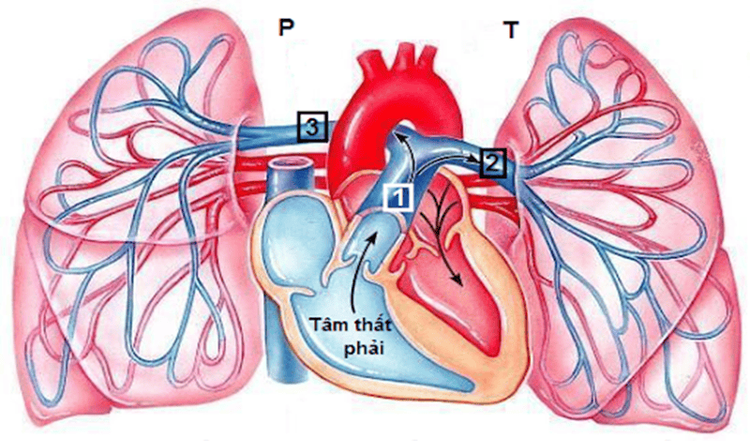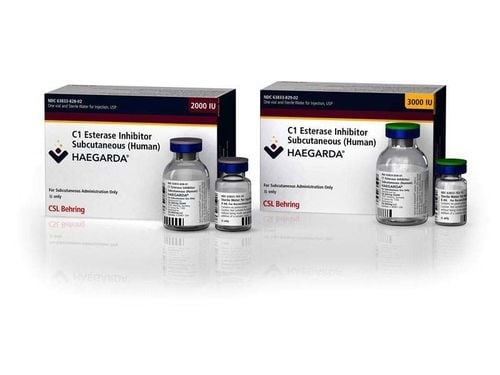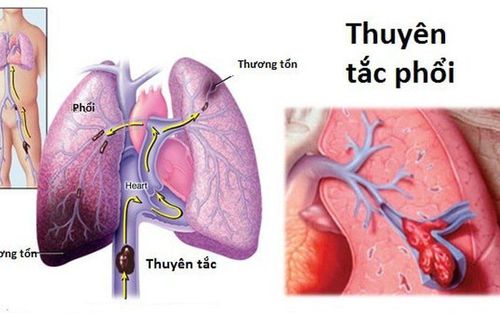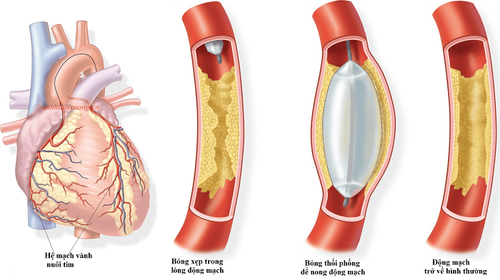This is an automatically translated article.
Acute pulmonary embolism is one of the top 3 causes of death related to cardiovascular disease today. This is a common disease, but it is difficult to accurately diagnose because it is easy to confuse it with other diseases. Without prompt diagnosis and treatment, patients with acute pulmonary embolism have a 30% chance of dying.
1. What is acute pulmonary embolism?
An occlusion of at least one pulmonary artery or branch of the pulmonary artery, usually caused by a thrombus from a deep vein that moves upward, is called a pulmonary embolism. This is a very difficult disease to accurately diagnose because it is easy to confuse it with another disease. Depending on the equipment of each medical facility, the ability to diagnose and treat will also be different, even with adequate equipment, but if you don't think about it, it is impossible to diagnose an artery occlusion. lung. Without proper diagnosis and treatment, patients have a mortality rate of up to 30%.
Acute pulmonary embolism usually originates from a thrombus originating in the deep venous system of the lower extremities. Occasionally, it also originates in the iliac veins, renal veins, right heart chambers, or veins of the upper extremities, but is quite rare. Massive blood clots can stop in the main pulmonary or lobar branches and cause hemodynamic changes after entering the lungs.

Tắc nghẽn động mạch phổi có nguy cơ gây tử vong cao
Pulmonary thromboembolism is a complication of an underlying venous thrombosis. Small thrombi are formed and lysed continuously in the venous circulatory system under normal conditions. If a blood clot is present in the pulmonary artery, it will block blood flow to the lungs to receive oxygen. Oxygen levels in the body drop dangerously if there isn't enough blood to receive oxygen and move it to the left heart, causing damage to all organs in the body, including the brain, kidneys, and heart. . The severity of the disease depends on how much blood is not reaching the lungs.
In addition, the pressure is returned to the right heart due to pulmonary embolism, causing the right heart to expand and contract more heavily. Blood pressure also drops if the heart can't pump enough blood.
These effects can all lead to death, either suddenly or after a period of untreated pulmonary embolism.
Besides, there are a number of other substances that are considered to be the cause of pulmonary embolism such as bone marrow fat after fracture, part of a tumor, air bubbles. But deep vein thrombosis is still the main cause of pulmonary embolism, so some doctors associate pulmonary embolism and deep vein thrombosis together.

Tắc nghẽn mạch làm tăng áp suất lên tim
2. Symptoms of acute pulmonary embolism
The most common symptom in patients with acute pulmonary embolism is sudden pleuritic chest pain with pain often increasing when coughing, sneezing, eating, taking a deep breath, twisting... difficulty breathing. In other cases, the symptoms of the disease are not obvious. Instead, severe hemodynamic changes, hypotension, shock, and coma may occur. Another symptom of pulmonary embolism is coughing up blood.
To diagnose pulmonary embolism, doctors rely on risk factors, clinical, and laboratory tests. The gold standard of pulmonary embolism is MSCT, but only hospitals with good technical facilities can do it at high cost.
Depending on the patient's condition, after the diagnosis is confirmed, the doctor may use anticoagulants, fibrinolysis (dissolving blood clots), or surgery.
3. Risk factors for pulmonary embolism
The following are risk factors for pulmonary embolism, including:
Age (over 70 years old) Patient lying in bed for a long time, lying in bed for a long time after surgery or trauma serious injury Medical problems such as heart disease Blood vessel abnormalities, such as varicose veins Having certain other conditions such as cancer or heart disease Women who are pregnant or within 6 weeks of giving birth Patients who smoke Obesity Obesity

Béo phì làm tăng nguy cơ tắc động mạch phổi
Traveling by car or plane for long distances without stopping or getting around Using birth control pills or hormones Having a history of blood clots Patient not taking prescribed blood thinners Genetic conditions such as blood clotting disorders Estrogen use Pleuritic chest pain Syncope Low blood pressure or shock Coughing up blood The chance of a blood clot increases the more risk factors are present. Deep vein thrombosis can be prevented if high-risk subjects are identified.
Acute pulmonary embolism is an emergency condition, requiring prompt diagnosis and treatment because the patient has a high risk of death if left untreated. Because the clinical symptoms of the disease are often nonspecific, the diagnosis is still difficult. It is necessary to apply diagnostic procedures appropriate to each treatment facility.
Vinmec International General Hospital with a system of modern facilities, medical equipment and a team of experts and doctors with many years of experience in neurological examination and treatment, patients can completely peace of mind for examination and treatment at the Hospital.
To register for examination and treatment at Vinmec International General Hospital, you can contact Vinmec Health System nationwide, or register online HERE.













